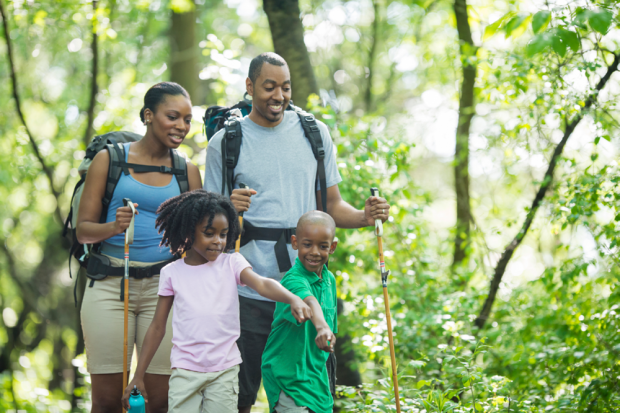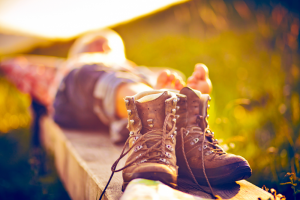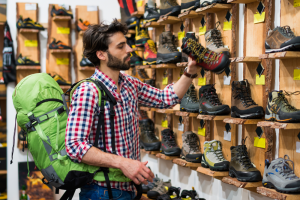Into the Woods How To Prevent Common Hiking Injuries
Hikers can avoid common issues like blisters, sore hips and knees, dehydration, exhaustion, scrapes and other injuries simply by following these easy trekking tips.
Whether you’re trekking through the mountains of Switzerland or rambling through the desert terrain of Scottsdale, hiking is a worthy and memorable outdoor adventure. But before you hit the trail for a hike, check out the following injury prevention guidelines to keep your outdoor escapade fun and pain free.
Overview: Hiking Injuries and How To Halt Them
Most afflictions hikers face can be prevented with a few simple steps, one of which is carrying a small first aid kit during each and every hike. Here’s everything you need to know about the most common hiking issues and how to treat and prevent them.
BLISTERS
Blisters are one of the most common injuries hikers face, whether they're experienced on the trials or just beginning. The most common culprits are wearing brand new shoes or hiking boots that haven't been broken in or wearing uncomfortable, ill-fitting shoes and shocks that aren't appropriate for the type of hike you plan to make. The friction between your skin and a possible irritant (your hiking boot, for example) can lead to the liquid-filled sacks, especially during long hikes when repetitive motion becomes involved.
Blister Prevention
Rough terrain and inclines create more stress to both your body and footwear, so always make sure you are wearing comfortable, well-fitted sturdy shoes such as hiking boots or athletic trainers. Never wear flip flops or sandals, which are unsupportive and leave your feet vulnerable to not only blisters, but also plantar fasciitis, bug bites and cuts and scrapes from rocks, twigs and other natural elements. You should also always wear performance socks made out of moisture wicking material, which can help ward off blisters and fungal infections that easily pop up when the feet are soggy for long periods of time. Wearing moisture wicking socks and regularly airing out your feet can also help cut down on foot sweat that causes you to slide around in your shoes and develop blisters.
Blister Treatment
If you feel a hot spot and know a blister is comining on, immediately cover the area with moleskin or a bandage to prevent further irritation. And if you do experience a blister (which happens time to time to even the most experienced hikers), you can help ease the pain by applying an antibacterial medicine and covering the area with a bandage.
JOINT, HIP AND KNEE PAIN
Putting a lot of mileage on your hips and knees can cause extreme soreness, especially when your hike involves uphill movement. And hikers that take on too much too soon run the risk of overuse injuries like illiotibial band syndrome (also called IT syndrome), bursitis and tendonitis.
Bodily Pain Prevention
Avoiding any kind of muscle and joint pain while hiking is all about preparation prior to your trek. This includes choosing well-cushioned shoes, working up to long distances with a training plan, stretching before, during and after your hike, using trekking poles or sticks to help with bodily support and resting when your body becomes fatigued or you begin feeling exhausted. If you’re already feeling hip, knee or joint pain before your hike, you should consider postponing your trip until you are healed and no longer feels aches and pains.
Bodily Pain Treatment
If you begin to feel sore during your hike, stop for frequent breaks, drink water to help with blood circulation, rub your muscles, consider taking an anti-inflammatory medication like ibuprofen, and try to find walking sticks to help decrease the stress on your legs and feet.
BUG BITES
Possible insect bites are an unfortunate side effect of being in the great outdoors, especially if your hikes take you near water. From gnats to biting flies to mosquitos, insects are almost impossible to evade.
Bug Bite Prevention
Most insect bites can be avoided simply by applying bug spray to your clothes and skin before leaving. You can also avoid bug bites by wearing lightweight pants and long-sleeved shirts, which help keep most of your body protected. If you'll be hiking in areas where you know insects will be a major problem, you may want to consider wearing a mosquito net over your head. Meanwhile, i fyou have known allergies, always remember to bring emergency medication like an epi pen on your hike.
Bug Bite Treatment
If you do get bitten by an insect, you can apply an antibiotic ointment or anti-itch spray to help with the pain and discomfort. Try not to itch the bite or sting, as that furhter irriates the wound.
CUTS, SCRAPES AND SUNBURN
Because hiking sometimes takes you through rough, unpredictable terrain, skin injuries like cuts and scrapes are common occurrences. Tree roots, loose rocks and slippery patches of ice and mud can cause trips, slips and falls that lead to bruises and scrapes on your hands, elbows and knees. Meanwhile, the sun can cause irritating sunburns.
Cut and Sunburn Prevention
One of the easiest ways to avoid cuts and scrapes is to pay attention to your surroundings. Be aware of things that can cause trips and falls, which not only cause cuts and scrapes but could also cause ankle sprains and bone fractures. Wearing the correct hiking shoes for your planned terrain can also help reduce trips, falls and resulting injuries.
Meanwhile, protect your skin from harmful UV rays by wearing long sleeves and pants and applying plenty of sunscreen at least half an hour before you begin your hike, being sure to reapply throughout the day if you’ll be out a long time.
Cut and Sunburn Treatment
Always carry a small first aid kit when going on long walks and hikes. If you do experience a cut or scrape during a hike, you can apply an antibacterial spray or ointment and a bandage to the wound to keep it clean and protected. Meanwhile, if your fall leads to an ankle sprain or bone fracture, you should follow the RICE Protocol (rest, ice, compression, elevation) to help decrease swelling and then use a walking stick or hiking pole to help get yourself to safety.
If you experience sunburn, be sure to drink plenty of water to help keep your skin cool. Some hikers bring soothing aloe vera gel squeezed into a small capsule just in case burns happen.
POISON IVY AND OTHER DANGEROUS PLANTS
Depending on the terrain you'll be trekking through during your hike, you may come into contact with dangerous plants like poison ivy, poison oak or poison sumac. Coming into direct contact with these plants not only causes serious skin irritation and itchiness, they can also cut your trip short if they are inhaled or if you or a fellow hiker is over exposed.
Poison Ivy Prevention
The best way to prevent poison ivy and other dangerous plants from wrecking your trek is to be familiar with the plants and the terrain you'll be hiking through, know ahead of time if poison ivy or other poisonous plants are in the area you'll be visiting, and wear long sleeves and long pants to protect yourself from exposure.
Poison Ivy Treatment
If you accidentally come into contact with their irritating leaves, you can apply Calamine lotion or any other soothing, anti-itch cream you have in your first-aid kit. If you inhale the poisonous plants or feel you've been overexposed, seek medical attention immediately.
DEHYDRATION AND EXHAUSTION
Dehydration happens faster than most people think, and because the body is made up of almost 90 percent water, it’s important to keep those fluids flowing. Drinking enough water also helps you fight off exhaustion, which can happen if you're not getting enough fluids, not eating the right trail snacks and pushing yourself too hard.
Dehydration Prevention
Drink plenty of water before, during and after your hike, which keeps your blood circulation strong and can even help ward off blisters and exhaustion. Consider drinking low sugar beverages with electrolytes for extra hydration during long trips. Expert tip: Drink about eight ounces of water every mile.
Dehydration Treatment
If you become dehydrated during your hike, you can munch on salty snacks to help replenish lost electrolytes or you can try to find a natural water source and use a packaged water purifier to make it safe for drinking. You also should try to avoid direct sunlight and hiking during the hottest part of the day, which is generally 10am – 4pm.
Signs of dehydration include dry mouth, a swollen tongue, increased thirst, weakness, dizziness, inability to sweat, confusion, heart palpitations and a decreased urine amount. Severe dehydration requires emergency medical assistance, so if you or your hiking partner experiences confusion, dizziness and other warning signs, seek help immediately.
Exhaustion Prevention
Feeling a little bit of exhaustion is normal (you are putting yuor body through quite an extreme and exhilleration experience, after all), but you can help keep your body in good shape and ward off tiredness by drinking plenty of fluids, eating high-calorie, nurtrient rich snacks and taking breaks throughout your trek.
Notice concerning medical entries:
Articles having medical content shall serve exclusively for the purpose of general information. Such articles are not suitable for any (self-) diagnosis and treatment of individual illnesses and medical indications. In particular, they cannot substitute for the examination, advice, or treatment by a licensed physician or pharmacist. No replies to any individual questions shall be effected through the articles.







